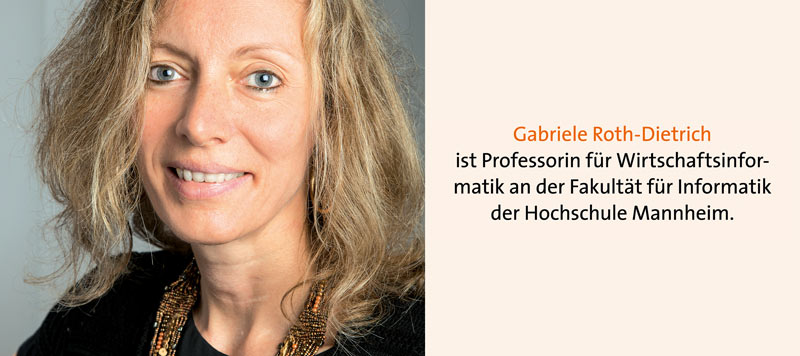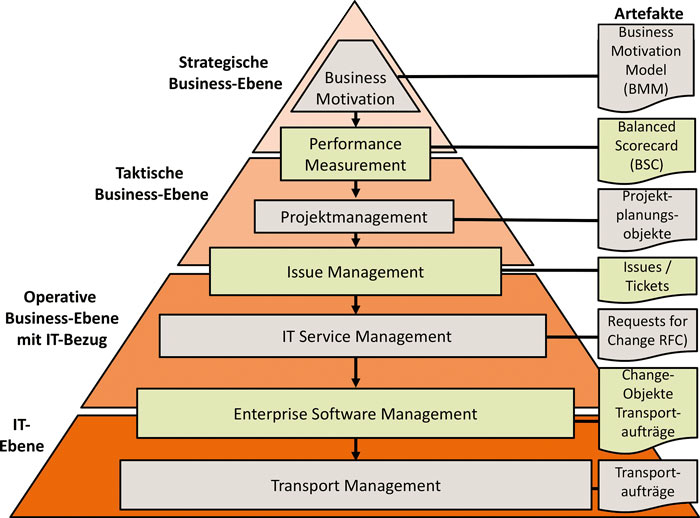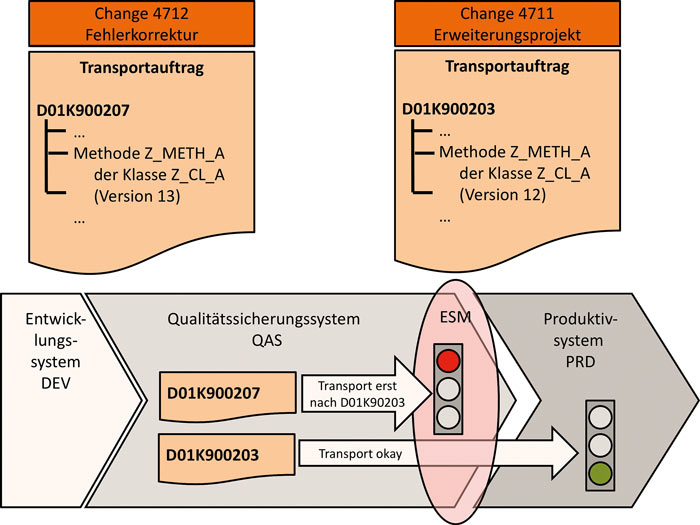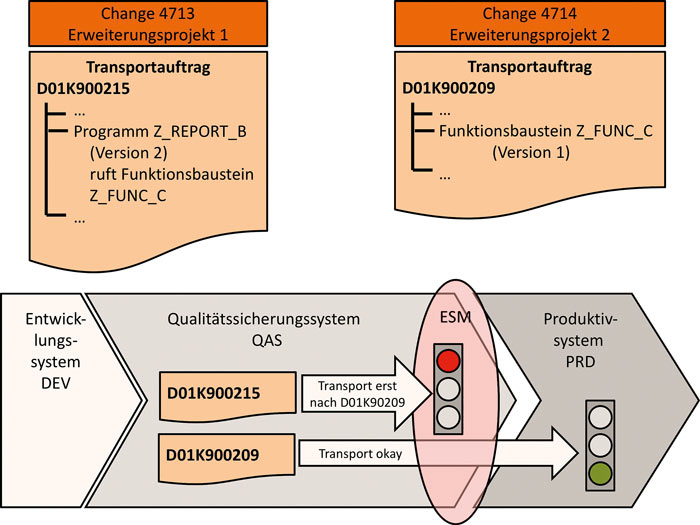Link between strategy and operational business


Terms such as Systems of Engagement and Systems of Records address the different IT requirements for the "new" system world, which must adapt to digitization approaches in an agile and flexible manner, and for the "old" proven business suite system landscape.
However, the two worlds should not be viewed separately in order to avoid isolated solutions. Instead, companies need a holistic IT concept that maps the IT tools for both strategic changes and operations as a whole.
Gap between strategy and change processes
Furthermore, in corporate practice there is often a gap between the corporate strategy at the highest level, the project management for strategy implementation, the breakdown to ITIL-compliant change processes - if software adaptations are required in a project - and the reference of a change process to individual detailed code changes at one point in the system landscape.
Vertical integration is missing here. Without transparency, however, it is difficult to compare project success and costs of digitization projects and to prove successful strategy implementation.
Further challenges arise from the areas of compliance and governance, which expect complete documentation of software adjustments with reference to the underlying change requests.
SAP system landscapes in particular bring a special degree of complexity to software adaptations, which have to be checked for inconsistencies in a wide variety of ways before they can be imported into the productive environment. Keywords here are 4-system landscapes, overwriters and overtakers, and critical and dependent objects.
Enterprise Software Management (ESM) closes this gap in two ways:
On the one hand, ESM tools integrate with project management applications and ticketing systems and therefore create a pass-through from corporate strategy to project plans and ITIL changes.
On the other hand, they manage the transport requests collected in the change processes, perform checks, warn of incompatibilities in the target system, and document the progress of each change for internal audits and auditing.
This integration service enables the efficient operation of the Systems of Records and at the same time creates scope for the planning and implementation of digitization projects, whose software adaptations they control in the same way as for maintenance tasks. In this way, they also contribute to the integration of the Systems of Engagement into the IT landscape.
Challenges for IT
The term digital transformation summarizes a variety of aspects of an increasingly digitized world in which established companies have to work on a fundamental realignment of their products, services, processes and business models in order to survive in an increasingly dynamic market environment [1].
Agility: Due to the drastic speed of change in market and competitive conditions, adaptable IT is a crucial success factor. The optimal IT system landscape for a long period of time replaces prototypes for digitization projects, which the project team supplements, develops further and scales flexibly in the event of success.
Ability to innovate: In the age of digital transformation, business priorities are shifting from incremental improvements to existing offerings to radically new ideas and start-up-like behavior.
IT must adapt to this change, for example with iterative approaches to software development process models such as Scrum and with DevOps for accelerated development, deployment and further development of applications and services.
Simplicity: It is not only customers who expect intuitive user interfaces and a consistent customer experience. The back office, which has to keep the complex and difficult-to-maintain legacy systems in operation due to adaptations, extensions and networking, also needs IT support for simple and expedient process control and communication. Efficient operation of the legacy systems is the only way to create the time available for digitization experiments.
Intelligent data utilization: Data collection, storage and real-time evaluation with intelligent evaluation algorithms add value to companies and are the prerequisite for process optimization, improved decision-making and business innovation.
The approach of operating a two-part system landscape is merely a transitional solution. Only by integrating the system worlds can companies avoid isolated solutions and, if successful, successively transfer mature prototypes to the product and service portfolio and to the familiar maintenance and further development processes.
ESM for measuring economic efficiency
With every digitization approach, companies must ask themselves whether the project meets expectations, whether it implements the corporate strategy appropriately, and whether the benefits outweigh the costs.
To answer these questions, they must transparently document and integrate all levels of corporate management. As a rule, the decision to digitize begins with the company's management, which clarifies its self-image and basic principles in its mission statement.
An electronic form of vision and mission, for example as a Business Motivation Model (BMM), helps to communicate the strategy direction in the company and makes visible the differences between the goals and purposes on the one hand and the means and ways needed to achieve them on the other.
As an example of a tool for BMM modeling, a prototype is mentioned that was created at the Mannheim University of Applied Sciences in the Faculty of Computer Science as part of a student project and has already been tested in practical use [3].
The transition to the tactical level of strategy implementation is formed by performance measurement systems, e.g., balanced scorecards (BSC), which take over the goals and define measures for goal achievement, for example, in project form.
The projects in the BSC can refer to work breakdown structures, networks, and work packages in project management systems where project managers plan, organize, and control the projects.
While some work packages can be processed without reference to IT systems, others require changes in the IT world. The project team members open tickets in issue management systems for these adjustments, for example.
These, in turn, are closely linked to IT service management, which often controls change processes via requests for change (RFC) based on ITIL.
Integration ends at this operational business level with IT reference at the latest. Transport management follows at the technical IT level in SAP environments, but there is no link to the business levels.
Enterprise Software Management (ESM) closes this gap (see figure) and thus contributes to business-IT alignment. ESM takes over the RFCs of IT service management and manages the change processes with their assigned transport requests in detail.
In this way, it is possible to trace at any time which RFC was the reason for which code change in which system and which transport requests supplied the productive system with it.
With the integration of all levels, management can see at the push of a button which strategic goal was to be achieved via which projects, which IT adjustments were necessary for this, and who implemented the change through which transport requests [4].
If one continues to think about cost-benefit considerations for a digitization strategy, ESM can form the basis for the effort-based assessment of software adaptations. For this purpose, all goals linked to the vision and mission for the strategy must be collected in the BSC and the stored projects evaluated.
All IT-related project work packages lead to linked RFCs or tickets and ultimately to change processes. Through integration with the ESM, it is finally possible to trace which code changes were made in the system landscape.
The change effort, for example on the basis of the effort estimate in person days, can be compared with an evaluation of the functional scope of the enhancements, for example according to the functional size measurement within the framework of a function point analysis.
Controllable transport risks
A detailed look into the IT layer reveals that even code changes with a small scope can unleash enormous complexities and pose a risk to the production environment.
The 3-system landscape with software adjustments in the development system, transport to the quality assurance system and testing there, and, if successful, release and import into the production system represents only the simplest scenario.
When the urgency of software changes varies, for example in the case of longer-running development, migration or upgrade projects on the one hand, and error corrections required at short notice on the other, many companies expand the 3 to a 4- or even 5-system landscape, in which a second development and possibly another test system bring the maintenance results promptly into the production system.
The planning, documentation and maintenance of system landscape components in an application lifecycle management system such as SAP Solution Manager may provide transparency of the landscape infrastructure, but the tools do not cover the analysis and testing of code changes in individual transport requests and with regard to their interaction with other requests.
Monitoring the process chain
To do this, companies also need Enterprise Software Management (ESM). The ESM monitors the entire process chain of object changes triggered by a change in all affected systems of the system landscape and manages or controls them centrally. A change process may generate a large number of transport requests at the IT level, which must reach the production system in the correct sequence.
The ESM keeps track of the impact of all code adjustments that arise in connection with a change process and monitors the interactions between the transport requests of all IT-relevant changes.
One possible risk is, for example, overwriters, where the transport management system first provides the productive system with the current version of an object, which is later overwritten by the import of an older code version of the object.
For example, two transport requests may contain the same object, such as a method of the class Z_CL_A, which on the one hand was changed as part of an enhancement project and for which on the other hand an urgent error correction had to be carried out.
For organizational and/or technical reasons, the testers were able to complete the testing of the bug fix faster than the testing of the enhancement project.
Nevertheless, version 13 of the method must not enter the production system until version 12 has been imported, since otherwise the older version 12 would overwrite the newer status from version 13 in the production system again. In this case, the error that was thought to have been fixed would be present again in the production environment.
Risk: Overtaking
Another danger is posed by overtakers. In this case, objects contain parts of developments whose counterparts only reach the target system in transports imported later, so that in the productive system the adaptation is incomplete and the application may react incorrectly. For example, executing a program requires a different object, perhaps because the program calls a function module or a method.
If the adaptations of the object and its callers reach the production system with a time delay, the application may not function as expected. If the interface changes in a way that is not upwardly compatible, for example because a transfer parameter that must be filled is added, all calling programs must follow the change.
Time offset when importing the transport requests, in which object and caller are located, then results in a dump. The same situation occurs when an object has been newly created, its callers have already reached the productive environment, but it itself is still on its way. Here, too, the program dumps during the execution attempt.
Overtaking scenario
An overtaking scenario occurs, for example, when a report Z_REPORT_B contains a call to the function module Z_FUNC_C in its code, but does not transport the module itself because it was created and brought into the quality assurance system by another project team as part of a different enhancement project.
Detecting overtakers is much more difficult than listing possible overwriting hazards, because the overtaken objects are not visible on the transport request. Only an extensive code analysis can help here.
With hundreds of transport requests and thousands of objects in them due to error corrections, in-house developments, extensions or upgrades, these dependencies and checks can no longer be managed manually and must be monitored by an ESM tool.
The decisive factor here is that the ESM tool acts largely automatically and monitors all transports by default in order to increase the stability of the target system, whether it is the quality assurance system, which benefits from improved test bases, or the productive system, where the impact of faulty imports is much more painful to notice.
Ideally, the ESM creates a list of critical transports and issues warnings about the dormant dangers therein. As an example of an ESM solution with extensive checking routines, consider Solutive's Enterprise Software Management.
Ultimately, an ESM tool for stakeholders with governance, risk, and compliance (GRC) requirements is also helpful beyond measuring the success of digitization risks and managing operational IT operations.
ESM for Governance, Risk and Compliance (GRC)
Internal business rules sometimes also address the technical handling of software modifications and require transparent adherence to the dual control principle for code changes, the separation of responsibility for development and testing among personnel, and the restriction of authorizations to what is adequate for the user role.
Audits and reviews find comprehensible evidence in the ESM for rule-compliant processes at the IT level. The ESM is also relevant for external audits. Auditors are increasingly asking to see the change processes and the applicable responsibilities.
If a company uses an ESM tool, it can generate clear reports around the adjustments to the productive environment at the push of a button and make them available at short notice upon request.
Documentation and evaluation of audit-relevant code changes are standard in several ESM tools, including Solutive's enterprise software management solution. The integration of the business and IT levels in the sense of business-IT alignment described at the beginning, on the other hand, still poses a challenge.
Proof of Concept Student Project
For this reason, a student project at Mannheim University of Applied Sciences is to carry out a cost-benefit analysis of digitization projects by integrating all levels of corporate management with the IT level via enterprise software management in the coming summer semester of 2018 as a proof of concept.
The plan is to use Solutive's Enterprise Software Management as the ESM solution, which already provides the necessary interfaces for integration into project management systems, ticketing systems and IT service management solutions.
Literature:
[1] Kreutzer, R. T., Neugebauer, T. and Pattloch, A., Digital Business Leadership. Wiesbaden, 2017.
[2] Châlons, C. and Dufft, N.: The Role of IT as an Enabler for Digitalization, in: Abolhassan, F. (ed.): What is driving digitization? Wiesbaden, 2016.
[3] Gröschel, M. and Roth-Dietrich G.: Modeling the Business Model and Business Strategy - Conception and Implementation of OMG's Business Motivation Model in a Software Prototype, in: Hertweck, D. and Decker, C. (Eds.): Digital Enterprise Computing 2016, Lecture Notes in Informatics (LNI). Bonn, 2016.
[4] Roth-Dietrich, G.: Innovative Digitalisierungsstrategien, in: ERP-Management, Heft 4 2017, pp. 32-34, Berlin, 2017.











1 comment
Zettlin
Ein sehr interessanter Beitrag, allerdings wäre es auch interessant zu erfahren, inwiefern es auch für andere ERPs relevant ist.